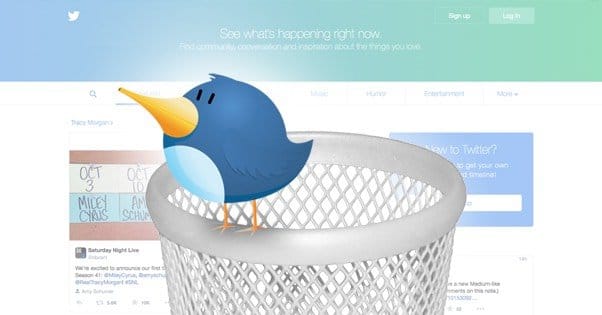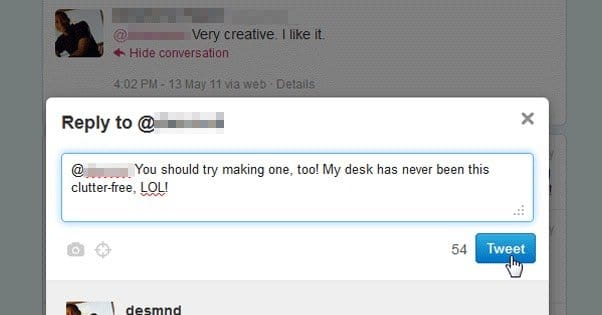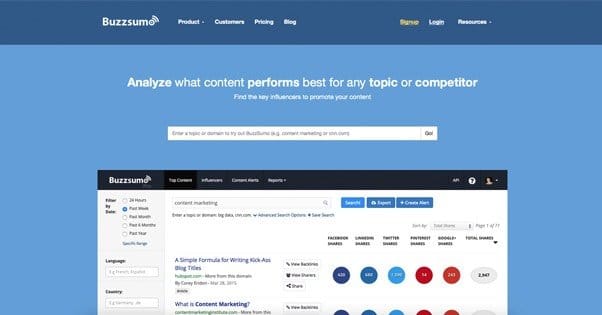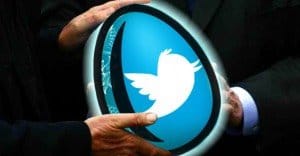 Written by ContentPowered.com
Written by ContentPowered.com
Among marketers, it’s an unquestioned reality that you need to work with social media if you want to be a success online. What’s more, when we talk about social media, we always talk about how Facebook and Twitter are the two biggest and most important sites to use. It’s arguable which one is better – and in fact we’ve discussed that very thing on this site before – but it always starts with one of the two. You start with one, you expand into the next, and you adopt other networks – like Pinterest, Instagram, Google+, or Reddit – once you’ve established yourself on the first two.
Is that true, though? A while back, we questioned that assumption about Facebook. Now, let’s question it about Twitter.
Reasons to Not Use Twitter
Well, first of all, there’s the growing thought that Twitter and Facebook both are dying. Or, rather, that the ability to reach your fans for free is dying. A Forrester study indicated that the average reach of a post was about 2% of an account’s followers, while engagement was less than .1%.
Of course, I see this as a bit of an apocalyptic scenario. I don’t know what brands Forrester studied, but they can’t have all been using the sites to their fullest potential. I know Facebook reach has gone down, and I know the press of Twitter posts has gone up, but it’s still not nearly so distressingly bad.
Engagement on Twitter is extremely transitory most of the time.
Many people use the “favorite” button in a way very similar to the way they use “like” on Facebook, but favorites tend to have less of an impact than likes, due to the lack of an EdgeRank equivalent. Retweets help, but when you have an audience of a million people and a person with 8 followers retweets your post, how much more benefit do you get from their followers seeing them? Hashtag retweets are more beneficial, but can end up with the opposite effect; too many copies of the same message flooding a tag and making discussion much harder to come by.
Twitter seems to be leaning more and more on a focus for activism, rather than marketing. This isn’t backed up by any data, but I’ve noticed that the majority of the most recent trends on Twitter have been activism of some form or another. It’s much harder for a branded ad campaign to compete with something like #WhyIStayed or #BlackLivesMatter. God help you if you try to hijack one of them with a marketing message; brands have been destroyed for less.
A very low number of people will actually click links; most are there to stay on the site and don’t want to be sent elsewhere. The “dirty little secret” of Twitter is that people spend more time browsing feeds than they do following links to off-site pages. You more or less have to rely on Twitter for branding; traffic just won’t be there. It’s not uncommon to have a million followers and have less than 5,000 clicking any individual link.
Why Twitter is Still Great
Whether or not you agree with the negative outlook posed by the above section, there are still plenty of good reasons to use Twitter.
Direct communications with customers are incredibly easy through Twitter. You have the ability to create a personal and accessible brand persona, which allows other users to feel very comfortable in approaching you. You, in turn, can communicate personally with them, in a way that promotes your brand. One of the top pieces of Twitter advice is to respond to everyone.
Twitter is very easy to use for branding yourself. Even individuals can do it, and do it well enough to receive verification. As a business, you can promote your brand in a personable and entertaining way. One-liners and quips are the common currency of Twitter, and if you can master the art of constant, low-key humor and interesting posts in general, you’ll be able to find easy success. My tip? Puns work wonders.
Twitter is an amazing platform for customer service. All of the brilliance of one on one interactions makes Twitter a fantastic place for constant customer service availability. Some brands do this better than others, of course, but I’ve seen people new to Twitter wholeheartedly adopt the platform when they complained to a business only to have that business acknowledge the complain and offer a resolution within minutes.
Twitter ads aren’t really all that great compared to other forms of PPC, so you can save money and use the platform for free. Plus, the option is always there for if you decide Twitter is worth the investment. I’ll probably write a more detailed guide on Twitter advertising another time.
There are a ton of tools to make Twitter easier to manage, including managing multiple feeds in one place. One great idea is to have one primary Twitter account for branding, that you use to promote your own content, curate the content of others, and engage with industry influencers. A second Twitter account dedicated to customer service allows you to refer service-seeking users to a central location, while maintaining your ability to support them through one central platform.
It’s easy to grow a follower base through skillful use of requests and contests. While asking for follows can be a bit of a desperate move sometimes, it doesn’t hurt to try now and then. I, personally, prefer the Woobox method. Run a contest and make “follow our Twitter account” one of the possible entry methods. As long as you follow the golden rule of online contests – that is, offer a prize that only attracts the people you want to attract – you can rake in the followers this way.
Even a low click rate can still be great with the volume you get from Twitter. A lot of times, people compare reach and engagement rates for one post on Twitter to one post on Facebook, but that’s an invalid comparison. If you’re using Facebook properly, you’re posting 1-2 times per day at the top end. If you’re using Twitter properly, you’re posting 10-20 times per day. Some experts even suggest posting as often as 4 times per hour. Your reach is low because, with an unfiltered feed, your Tweet typically only has a lifespan of half an hour or so. During peak hours, it might only last for minutes. That said, 1,000 clicks per post, 20 posts per day, is quite a bit of traffic for not a lot of effort.
Chances are, people are actively talking about you on Twitter. They might not mention you, they might not use your hashtags, heck they might not even use the right name for your products, but the discussion is there. If you don’t take advantage of it, someone else will. It’s generally a good idea to take control over your branding so you have as much exposure to your customers as possible – and so you can keep your competition out.
And really, you just can’t beat the price.
Tips for Successful Twitter Marketing
Tweet more than just branded product-relevant content; tweet about supplemental content. A brand like Nike, promoting athletic apparel, can tweet about sports, about fitness, about world records, about nutrition – anything their customer base would be interested in seeing. Content that resonates with your audience is the key to growing it and keeping it as engaged as it gets.
Another thing I mentioned above is responding to everyone. It takes virtually no effort to check Twitter once an hour and respond to incoming comments. Chances are you won’t have all that many. In the early days, when your audience is small, you can even set up alerts so you can respond immediately instead of waiting for a designated check time. This kind of strategy does tend to fall apart if you’re getting hundreds of comments an hour, but at that point, you don’t need petty strategies to grow.
You can also consider expanding and branching out. If you find that you tend to have two divergent set of interests, you can create individual accounts for each primary set of interests and focus more on each of them. Your audiences will be smaller, but they will be more focused and, ideally, more engaged.
Be very wary of automation. It can be very tempting to automate several aspects of your Twitter presence, but it’s very obvious when you do, and the disconnect between real interaction and robotic autoresponses will hurt you.
- Don’t autorespond with formulaic messages, particularly on a customer service account.
- Don’t auto-follow anyone who ever interacts with your page. When a random business follows me for no reason, I’m immediately skeptical and less likely to follow them back.
- Don’t schedule tweets to go up and fail to be around to respond to comments when they occur. Again, responding to people is the key to engagement, and if you automate and run, you lose all of that benefit.
I recommend investing in tools that allow you to create custom streams based on keywords or hashtags. This allows you to monitor various minor sub-communities within your industry, and it allows you to step in when you have something relevant to say. It’s all a little Big Brother, but it’s very effective.
Don’t forget the broad social listening. Don’t rely on people specifically using your #BrandedHashtags or directly @Mentioning you. Instead, set up social listening alerts for when people type your business name or product name in plain text.
Post about more than just your business and brand. If all you’re doing is posting a blurb every time a blog post goes up and hyping up your product, your followers might as well just subscribe to your RSS feed instead. Curating content is one good step. So is striking up conversations with more influential businesses and individuals in your industry.
Obviously, make sure you’ve filled out your profile completely. If you’re running more than one branded account, make sure that they both have identical branding, but that they can still be told apart at a glance. You can make your primary profile a little more casual than your customer service profile, for example, because the people coming to you for support are looking for something more professional. As part of filling out your profile, you need to consider:
- Your display picture. This can be your company logo, or it can be a headshot of your community manager, or even just an attractive picture of your store.
- Your background image. This is akin to your cover photo on Facebook, only it’s larger and gives you more real estate to work with. I recommend something attractive, graphically, and representative of your business. Try not to make this overly branded, but feel free to use it for special announcements.
- Your description. You don’t have a lot of room here, which is a theme on Twitter. Go with the absolute basics. If you have a customer service account, include a “For Customer Service questions, tweet @OurCSAccount” line.
- Your location. This is worth filling out even if you don’t have a physical storefront, because it helps people know where you are, whether or not you’re local, and what to expect when interacting with you. Interactions will be very different if your locale is listed as Baghdad compared to Minnesota.
Find and follow industry influencers.
You can use a service like BuzzSumo to help you with this, or you can just keep an eye out for the influential people and businesses in your industry and see if they have active Twitter accounts. Follow them, retweet any post they make that’s relevant to your niche, respond to questions they pose, and generally interact with them as much as possible. Not only does this get you activity that isn’t self-promotional, it puts you on their radar as a potential fellow influencer who they might want to follow.
Don’t be afraid to post your tweets more than once. You can retweet yourself, or you can post the same link with an “In case you missed it (ICYMI)” repost. Tweets live and die very quickly unless they trend, so it’s worth posting them so people who browse later can see.
Participate – carefully – in trends on Twitter. Remember the famous Superbowl blackout? Oreo make a nearly immediate and excellent tweet capitalizing on it with a lighthearted joke. That’s the kind of interaction you want. Remember the #WhyIStayed hashtag about domestic abuse? DiGiorno tried to make a joke there, and the backlash was immense. Always review the intent behind a hashtag trend before you attempt to use it for humor.
Remember how I mentioned volume, like, seven times in the previous sections of the post? Volume is very, very important. You can’t go overboard and post a dozen times an hour every day, but neither can you abandon your Twitter account for days at a time. When only a small percentage of your followers see any given post, you need to post frequently throughout the day to reach as many of them as possible. Post frequently and consistently, and never skip a day.
Use hashtags, but use them sparingly. Not all tweets need hashtags. No tweet should ever have more than two hashtags. You can make up your own tags, but before you use them, check to make sure they aren’t actively in use by some other brand for an entirely different purpose. The last thing you want to do is accidentally attempt to hijack the marketing efforts of someone else. A good tip for making a tag unique is to add branding. For example, instead of #SummerSale, you might use #MyBrandSummerSale.
Of course, don’t forget to promote your Twitter account through other portions of your online presence. Blog social sharing buttons are a good start, but you can also consider adding tweetable lines to the top or bottom of your post, so users can tweet them with one click. You can also use a script to bring up a “tweet this” box any time a user highlights content on your page.
Consider, as well, some of the “follow” rules as put forth here by Ken Krogue. He suggests:
- If someone follows you, follow them back.
- If someone favorites one of your tweets, follow them.
- If someone follows you, offer something in return, even if it’s just acknowledgement.
These aren’t always inviolable rules; they don’t always apply to every situation. Be wary of bots abusing them, and be wary of following too many accounts that don’t have anything valuable to say to you.
Overall, Twitter is great to use, as long as you’re actually using it. Publishing poor content, or failing to publish content; those will kill your traffic easily.



